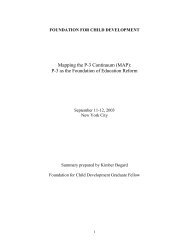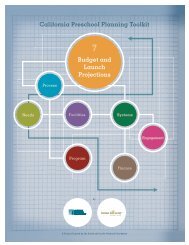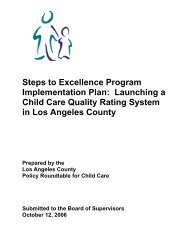STRATEGIC FINANCING: - National Academy for State Health Policy
STRATEGIC FINANCING: - National Academy for State Health Policy
STRATEGIC FINANCING: - National Academy for State Health Policy
Create successful ePaper yourself
Turn your PDF publications into a flip-book with our unique Google optimized e-Paper software.
community collaborative as the lead agency <strong>for</strong> this financing arrangement, the financing strategy<br />
becomes a vehicle <strong>for</strong> not only bringing new revenue to the community <strong>for</strong> previously existing<br />
activities, but the financial strategy can also be used to strengthen community collaboration and<br />
local governance. 16<br />
Considerations<br />
To the extent that local public expenditures qualify <strong>for</strong> federal matching funds or can help build<br />
the infrastructure to qualify other public spending <strong>for</strong> federal matching, the total amount of new<br />
funding available <strong>for</strong> child and youth programs can increase substantially. One of the great<br />
strengths of maximization strategies is that they can potentially create a sustainable funding base.<br />
Even if they draw down only small amounts of money in a constant and enduring way, they can<br />
provide a stable and reliable base of funding. Once started, the flow of funds continues.<br />
Another strength of maximization strategies is that they are not confined to a single agency or<br />
program. They can be implemented horizontally across several programs and services --<br />
including child welfare, juvenile justice, homeless services, and domestic violence -- to identify<br />
local spending that qualifies <strong>for</strong> federal reimbursement.<br />
A benefit of leveraging federal funding is that the new revenues actually increase opportunities<br />
<strong>for</strong> additional leveraging. The new federal dollars, in effect, replace a share of state and local<br />
spending to support programs and services. These resources are then freed up <strong>for</strong> other purposes.<br />
To the extent that they are used <strong>for</strong> activities that also qualify <strong>for</strong> federal reimbursement, they can<br />
leverage additional federal revenues. 17<br />
Many discretionary or program grants provided by government and private funders require<br />
matching funds. When applying <strong>for</strong> these grants, program leaders need to be aware of the<br />
matching funds requirements and rules.<br />
Local leaders do not have the authority to directly access many federal funding sources because<br />
these funds flow through state government agencies and, in some cases, are co-mingled with state<br />
dollars. To ensure that federal and state funds are allocated in ways that respond to community<br />
needs and priorities, local leaders need to develop strong working relationships with state<br />
officials. They are often more likely to be successful in their ef<strong>for</strong>ts to influence allocations if<br />
they approach state officials as a coalition and work with other programs and initiatives to<br />
demonstrate the broad applicability and benefit of the approaches they advocate.<br />
18

















